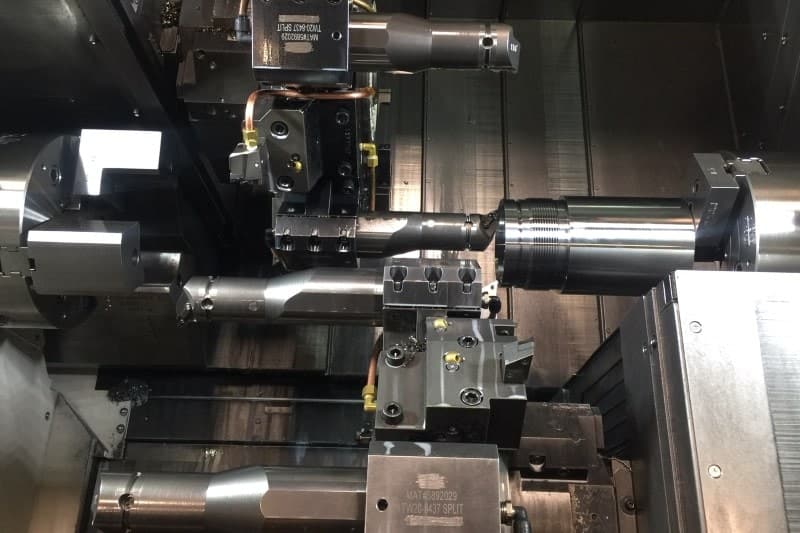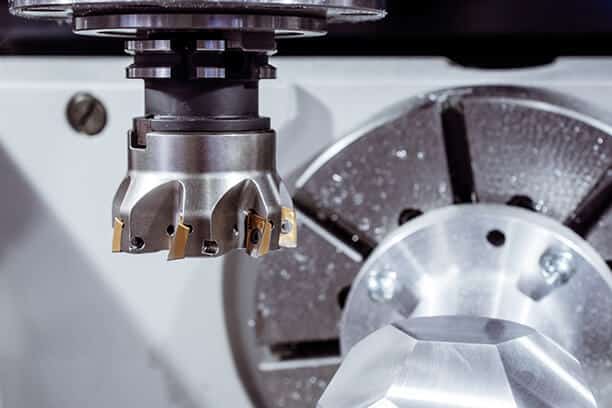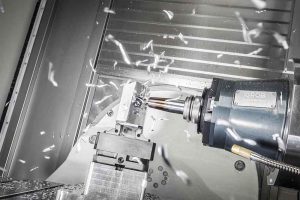Top CNC precision technologies include high-speed machining, multi-axis systems, automated calibration, adaptive control, and software integration, optimizing accuracy and efficiency in production
High Speed Machining
The phenomenon of High Speed Machining has made a breakthrough in the world of manufacturing by providing enormous gains in terms of efficiency and accuracy. High Speed Machining implies running the milling process on a high spindle speed and feed rate. This allows for high productivity because the material can be removed very fast, which, in its turn, shortens the overall production time. The advantages of High Speed Machining become apparent when the product has complex geometry or fine details. Particularly, this phenomenon is widely used in the aerospace and automotive industry.
Main Principles of High Speed Machining
The basis of operation of High Speed Machining is taking a small and elongated cut at high feed rates. It is exactly the opposite entity of standard machining, where the cut is typically thicker and longer, while the speed is lower. Rapid material removal is beneficial for both productivity and quality. First of all, the heat has no time to accumulate and distort the workpiece, which often happens otherwise. Secondly, since the workpiece remains cooler, it is more homogenous, and its tolerances are more narrow and even. The end result is a more accurate geometry of the details and a better surface quality of the object.
Technological Requirements for High Speed Machining
The core component of HSM is central to the following requirements. The CNC mill has to have a spindle that operates with a speed of at least 25,000 rpm. Also, these machines are endowed with high feed rates and a rigid motion system. The control system of such machines is to be implemented in such a way to account for the dynamic direction changes of the tool path.
An example of a suitable machine for HSM is the Haas VF-2TR. This control system is programmed with the help of special high-speed machining graphics coating. To meet the requirements for high speed, this particular machine is equipped with a 30,000-rpm spindle.
Materials and Cutting Parameters
Experience shows that not every material is suitable for acceptance of high-speed machining. Ideally, the suited materials should be very soft and not wear-resistant. These materials include aluminum and magnesium and the majority of very soft steels. As for titanium or other heavy metals, a special cutting geometry is used, and the result is more modest. It is reasonable to slow down the machining speed in order not to damage the workpiece and the abrasive tool.

Multi-Axis Machining
Multi-Axis Machining is a substantial development in CNC technology that allows for the producing of detailed and complicated details with high accuracy. It uses machines functioning along four, five, or even more axes and provides a number of critical advantages, especially in the sphere of activities requiring extreme precision, such as aviation, medical, and automotive industries.
Principles and Skills
In general, Multi-Axis machining is primarily intended to enhance skills for moving a workpiece or a tool along multiple axes at the same time. As a rule, typical three-axis machines move in X, Y, and Z linear directions. Meanwhile, the equipment with four or more axes also recognizes rotation around one or several axes, typically referred to as A and B axes, which allows the cutting tool to work on the workpiece along any direction. The major advantage is in the reduction of multiple setups, production time, or diversity of manufacture on the same workpiece due to the ability of using high degrees of complexity
Technological Innovations and Equipment
The most advanced Multi-Axis machines are equipped with options available to transform up to nine axes. In addition to this, they are generally designed with the intent to optimize tool paths, improve the workpiece’s surface, and increase lifespan due to control over the tool’s angle and feed. Moreover, the relatively new High-Speed Spindle technology currently allows machines to function with speeds up to forty-thousand RPM. Many Multi-Axis machines are currently used along with the well-known DMG Mori Seiki NMV 5000.
Material and Descriptions
The necessity for sophistication is especially important in the work with complicated materials, such as titanium and Inconel, used in aviation industry. They require the most precise approaches to tooling that allows the reduction of stress and the proper distribution of heat. It is especially important for Multi-Axis machining, as, with the change of the cutting tool, it may transform the angle directly depending on the necessity. This process is applied directly to control the cutting conditions and provide additional protection from tool wear for hard-to-cut metal. A common example of Multi-Axis Machinery application is the work with aviation blades required for turbines. Although manufacturing cutters are greatly intricate, they can be applied with high precision through the use of Multi-axis technology in one step without others.
Automatic Tool Calibration
Automatic Tool Calibration is a technology which plays an important role in the CNC machining as it ensures an extremely accurate and precise operation of tools. The tool is automatically adjusted in terms of its position and orientation in relation to the workpiece. Similar to disk sander calibration. Such calibration provides chance for the perfect machine and workpiece position on each in all planes. This technology increases the degree if machining and tool longevity. It is especially important in the high precision industries such as semiconductor manufacturing and precision engineering. This technology allows for the constant maintenance of the high standards of quality.
The Role of Precision in Tool Calibration
The main process involves the calibration of the machine tool which is the adjustment of machine tools to the certain degree of tip in order to have those identified with the machined workplace. It is important to have it done as even minor deviations in the process may result into substantial defects in the final product. Automatic tool calibration eliminates human error and make the calibration process real-time.. In the current systems this is done with the application of sensors and various software algorithms.
Technology Behind the Automatic Tool Calibration
Automatic tool calibration is mainly associated with the implementation of the sensors and measurement systems to detect the variance in the tool position and the actual position commanded. For example a laser measurement of the tool geometry and available offset in the control system. Depending on those data the tool path is adjusted or the tool data stored in the controller is adjusted. In the final result the manually checked samples are eliminated and each component produced is checked for changes.
Benefits/Operational Efficiency
There are many benefits of the application of the automatic tool calibration. One of the main is the decrease of the downtime. For example, previously, the process was done manually, and took certain amount of time, whereas now it is done in real time. It is also important especially for the mass production where due to the large changes in time many parts may be send to separate places risking the production of parts of different quality and leading to the decreased customer satisfaction.
Automotive Industry
In the automotive industry the components should be made to the exact specifications as the defects in the minor components may lead to the failure of the big systems. One of the main examples is the components which make the engine. The major automotive manufacturer has decided to implement the automatic tool calibration system to the CNC machines which make the components. The company’s representative says that they decreased the waste of the scraps by 50 percent as well as speeded the production by 20 percent. The head explains that from the first to the last part all were samples were made in a way that required no intervention.
Adaptive Machining
Adaptive Machining is a highly sophisticated CNC technology that dynamically changes machining parameters on the fly according to sensors-based feedback from the cutting process. This technology is essential for industries dealing with issues of inconsistent materials or complex part geometries throughout, such as in aerospace or custom manufacturing.
Core Concepts and Functionality
Adaptive Machining actively monitors the cutting process using sensors and a software system. the technology changes cutting speeds, feed rates, and even the toolpath according to variations in hardness of the workpiece, anomalies in the hardness of material, or even the wear of the specific tool. In this way, machining parts always stay at optimal cutting conditions. As a result, this technology increases the quality and precision of machined parts.
Technological Integration and System Components
The system uses a combination of force, temperature, and vibration sensors placed on the CNC machine. These sensors collect the data that is constantly provided to the onboard computer system. As a result, in the case of excessive vibration, it reduces the feed rate. In addition, in case of spindle going beyond critical temperature speeds, changes or stops can be performed. these behaviors stabilize the cutting tool.
Benefits and Efficiency Gains
Adaptive Machining allows for the process of cutting to adapt to the changing conditions. tool failure and wasted material is minimized. the process of cutting is more efficient, and resources are used in a much more efficient manner. there are also gains in higher tool life within the system, so there is less time of the system being shut down. There is also increased machining accuracy, meaning that Adaptive Machining can still be cost-efficient in the context of high-volume manufacturing – a critical feature for the aerospace industry.
Real-World Applications
In aerospace component manufacturing, there are complex shapes of parts and tough, exotic materials being utilized in the process. Consequently, machining Titanium airframe parts and similar technological problems are solved with Adaptive Machining. In the cutting of titanium, Adaptive Machining deals with its toughness and unusual cutting conditions along with intricate geometries along the way.

Advanced Software Integration
Advanced Software Integration is the application of cutting-edge software to boost the capabilities of Computer Numerical Control machines that are used to carry out operations with elevated precision and efficiency. The presented technology is essential in any field where complex designs and small tolerances are necessary, and it is especially crucial in aerospace, automotive, and electronics, among other industries.
Essentials of CNC Software Integration
First and foremost, the integration of advanced software includes CAD and CAM systems that form the basic framework of the technology. On one hand, engineers can use Computer-Aided Design to create their parts and prepare them for the machining process, ensuring high levels of precision and accuracy. On the other hand, Computer-Aided Manufacturing such as Autodesk Fusion 360 and Mastercam will ensure a smooth transition from their design to the completion of machining. Through this technology, a CNC machine will be able to perform complex patterns and cuts previously set by the designer.
The Role of Real-Time Data Analysis
On a more profound level, an incorporated software system also includes the process of real-time data analysis, which monitors the progression of the machining process and allows for immediate adjustments of machine operations. This capability is essential for quality purposes and normal operations since in case of any tool wear, improper material, or any other inconsistency, the software will automatically adjust the machine to correct the issue. More precisely, the integrated data analysis can be used to notice the discrepancy of used equipment and its original state, and the software can adjust conditions such as feeds, speeds, and temperatures to correct the issue.
Automation
Finally, modern software integration can also incorporate Automation in its industry through the development and connection to Internet of Things. This system can facilitate the connection of CNC machine to a programming network, where it would be automatically monitored and serviced.









